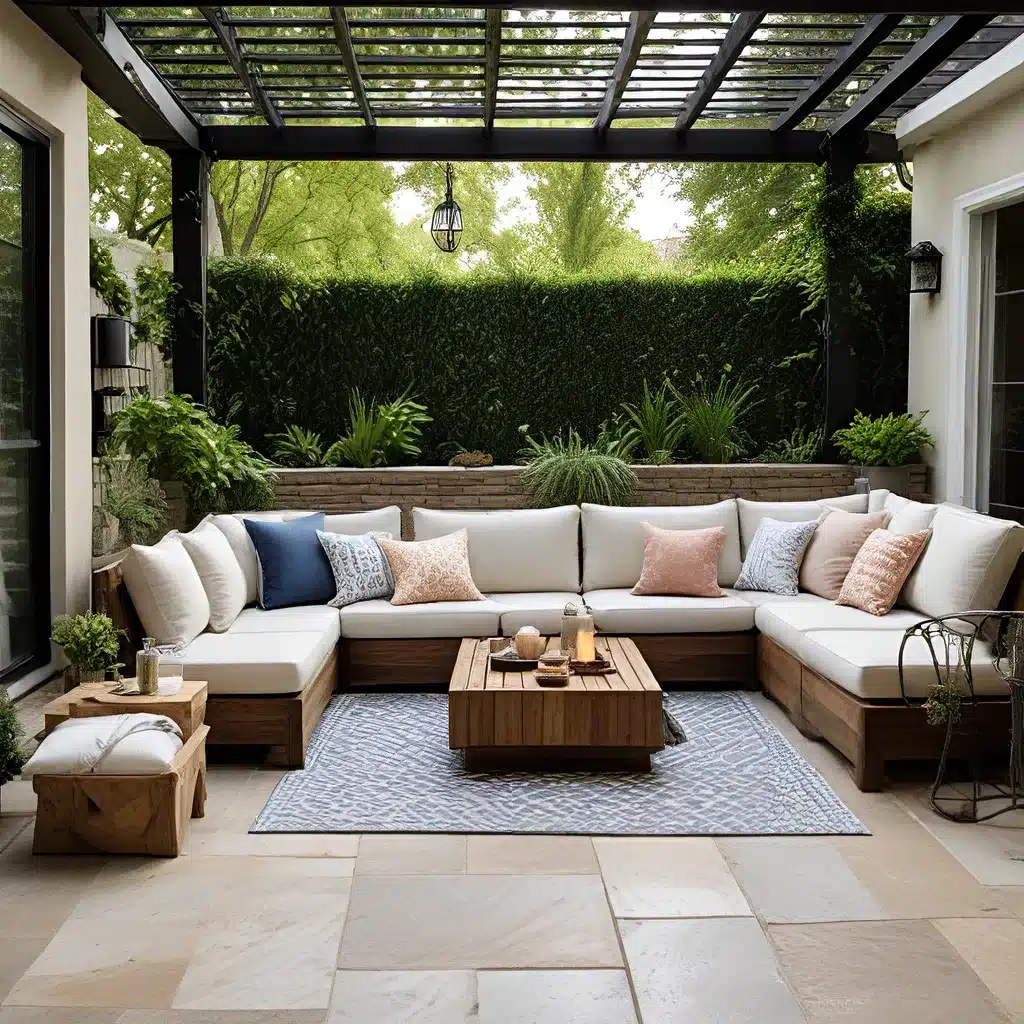
In today’s world of compact living and a growing emphasis on outdoor spaces, homeowners and design enthusiasts alike are seeking ways to maximize the potential of their patios. Whether you’re working with a small urban balcony or a more expansive backyard retreat, the art of space planning and functional design can transform your patio into a true oasis of style and comfort.
Embracing Compact Elegance
When it comes to small patio designs, the key is to strike a delicate balance between form and function. As the experts at Architectural Digest note, “When considering a design, it is so important to think about what the space you are designing is going to be used for.” This thoughtful approach ensures that every square inch of your patio is maximized to meet your unique needs and preferences.
One of the hallmarks of a successful small patio is the strategic use of multifunctional furniture. Opt for pieces that serve dual purposes, such as ottomans with hidden storage or benches that double as additional seating. By cleverly incorporating these versatile elements, you can create the illusion of a larger, more open space while maintaining a cohesive and visually appealing design.
Layering Textures and Hues
When it comes to small patio design, the use of texture and color can have a profound impact. As landscape designer Lisa LaPaso notes, “In this intimate space above, the need was to add color, hide the neighbor, and give the illusion of more space. I created a layering effect that draws the eye upward to the front of the house, the interesting architecture, and I created curves in the rectangular beds to add warmth with an organic feel.”
By incorporating a variety of textures, such as smooth stone, weathered wood, and lush greenery, you can create a visually stimulating and cohesive design. Additionally, the strategic use of color can help define different zones within your patio, directing the eye and creating a sense of depth.
Maximizing Vertical Space
One of the key strategies for small patio design is to take advantage of the vertical space available. This can be achieved through the use of hanging plants, wall-mounted shelves, or even vertical gardens. By utilizing the often-overlooked vertical dimension, you can free up valuable floor space while adding a dynamic and visually interesting element to your patio.
Another way to maximize vertical space is by incorporating raised garden beds or tiered planters. These elements not only add visual interest but also provide an opportunity to introduce a variety of plant life and textural elements to your outdoor oasis.
Blending Indoor and Outdoor Living
In recent years, the line between indoor and outdoor living has become increasingly blurred, and modern design trends have embraced this seamless integration. When designing your patio, consider incorporating elements that bridge the gap between the interior and exterior of your home.
This can be achieved through the use of oversized windows, sliding glass doors, or even retractable walls that allow for a fluid transition between the two spaces. Additionally, incorporating similar materials, color palettes, and design motifs across your indoor and outdoor living areas can create a cohesive and visually harmonious aesthetic.
Optimizing Storage and Organization
In a compact patio setting, storage and organization are paramount. Invest in built-in benches with hidden compartments, vertical shelving units, or ottomans with concealed storage to keep your outdoor living space clutter-free and visually appealing.
Additionally, consider multifunctional pieces that serve both decorative and practical purposes, such as side tables with integrated planters or benches that double as extra seating. By carefully planning your patio’s layout and incorporating these smart storage solutions, you can ensure that your outdoor oasis remains both stylish and highly functional.
Embracing Sustainable Design
As homeowners and design enthusiasts become increasingly conscious of their environmental impact, sustainable design has taken center stage in the world of patio design. This can include the use of locally sourced, eco-friendly materials, the incorporation of drought-tolerant or native plant species, and the implementation of water-efficient irrigation systems.
By prioritizing sustainability in your patio design, you can not only reduce your carbon footprint but also create a harmonious and visually stunning outdoor space that respects the natural environment.
Personalized Touches and Luxury Accents
Ultimately, the key to a truly exceptional patio design lies in the personalization of your outdoor living space. Whether it’s the incorporation of custom-made furniture, the selection of unique art or decor pieces, or the addition of luxurious amenities like an outdoor kitchen or fire pit, these personalized touches can transform your patio into a reflection of your individual style and preferences.
By working with a professional interior designer, you can ensure that your patio design not only meets your functional needs but also elevates your outdoor living experience with bespoke solutions and high-end finishes. The collaboration between homeowner and designer can result in a truly one-of-a-kind outdoor oasis that seamlessly blends form, function, and personal flair.
In conclusion, the art of patio design is all about striking a balance between stylish aesthetics and practical considerations. By embracing compact elegance, layering textures and hues, maximizing vertical space, blending indoor and outdoor living, optimizing storage and organization, and incorporating personalized touches and luxury accents, you can create a truly exceptional outdoor living space that reflects your unique style and lifestyle.

